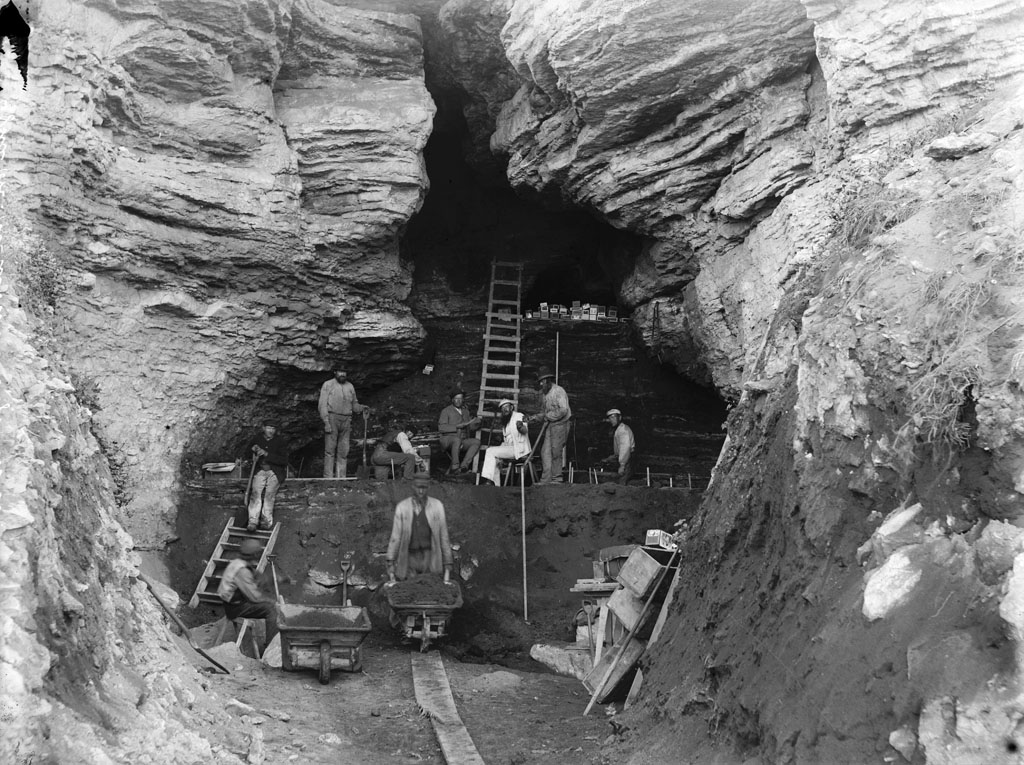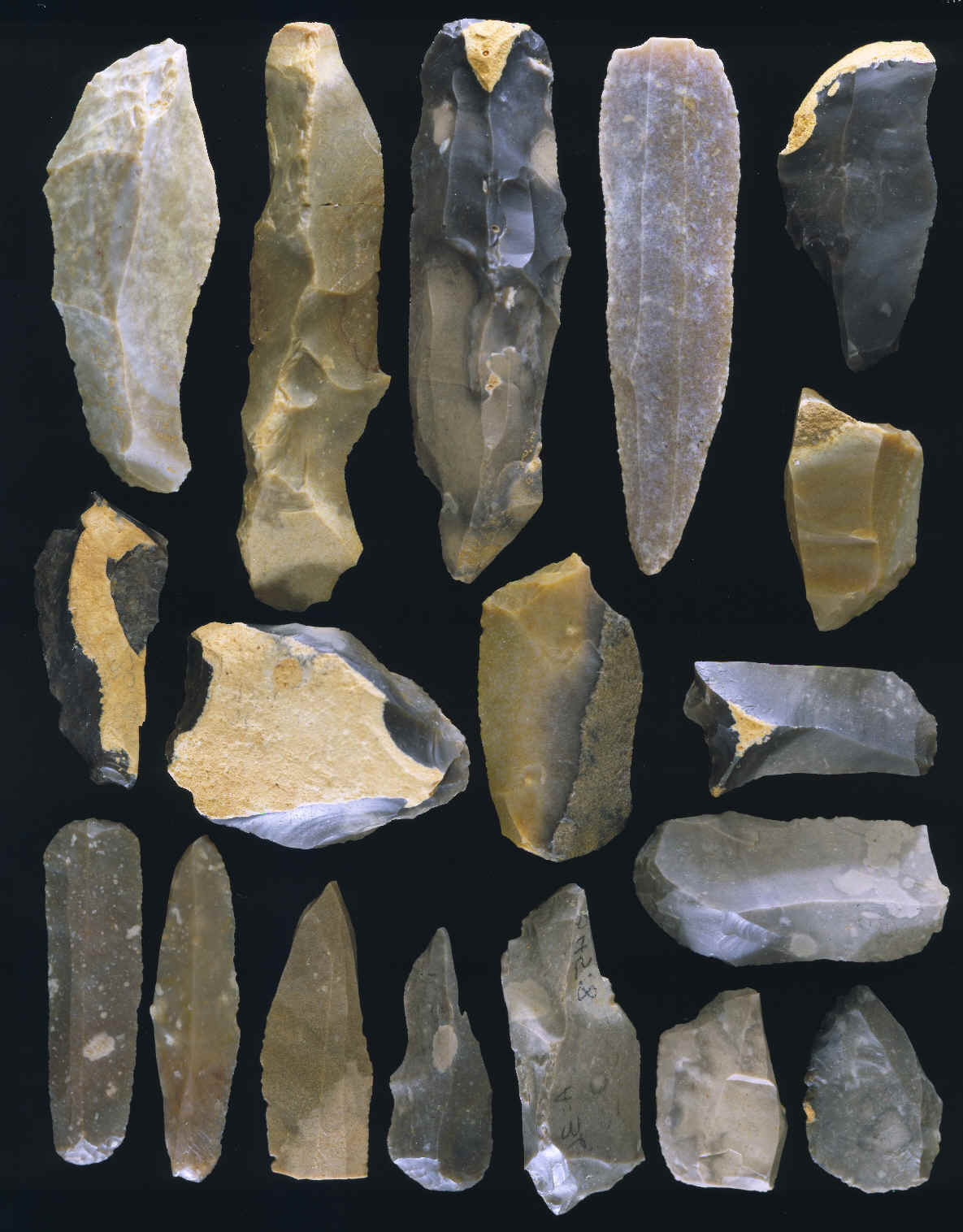Location map of Homo Sapiens Aurignacian culture, of the Upper Paleolithic Age
 Topics on the Page
Topics on the Page
Paleolithic Age
 Cave Art and Cave Paintings
Cave Art and Cave Paintings
Habitats & Hunting
 Tools and Fire
Tools and Fire
 The String Revolution
The String Revolution
 Bead and Other Art
Bead and Other Art
Women's Roles
 Teaching and Learning Resources
Teaching and Learning Resources
|
This page discusses Paleolithic societies, including cave art and cave paintings, habitats, hunting, tools and fire, bead art, and women’s roles.
- The Paleolithic age lasted until around 10,000 BCE. During this age, caves became more complex to protect humans from predators.
- The people of this age were nomadic as well.
- As for tools and fire, harpoons were constructed to hunt larger mammals, such as the Wooly Mammoths.
- Bead art was something that Hunters and gatherers during the Paleolithic age took pride in, as they were displays of success in hunting.
- The “string revolution” explains how societies and women adapted and evolved along with new technologies.
Page Summary by Patience Gubisch (February 2023) & Vanessa Vincent, February 2022)
|
Focus Question: What were the characteristics of the hunter-gatherer societies of the Paleolithic Age?
Excavation of a Stone Age Cave, Island of Gotland, 1891

Hunter-gatherer societies were marked by the use of tools and fire, basic hunting weapons, beads and other jewelry.
- These societies also had a basic form of social organization, a concept that applies to all human societies throughout time.
- Students can see how different groups organized themselves to sustain their lives economically, socially, politically, and philosophically.
 View a good introductory video about the Paleolithic Age.
View a good introductory video about the Paleolithic Age.
Inventing the Stone Age, an interactive timeline from John H. Lienhard at the University of Houston. Check out track seven: The Dolni Vestonice Venus

Women were Early Big Game Hunters of America, Research Suggests
Female Hunters of Early America, Science Advances (November, 2020)
Paleolithic Age (Up to - 10,000 BCE)
For a modern day perspective, link to How Matera Went from Ancient Civilization to Slum to a Hidden Gem from Smithsonian Magazine (February 2014).
This age can be defined as beginning with the earliest human-like behaviors of raw stone tool manufacture and ending with the beginning of cultivation. The people of the Paleolithic Age, or the Old Stone Age, lived in hunter-gatherer communities. This meant that food was found on a day to day basis, as opposed to the modern day agricultural methods of food production and preservation.
Timeline of Tool Makers through the Paleolithic Age (*Modern man’s scientific name is Homo sapien)
- Homo habilis - 2.2 to 1.6 million years BCE
- Homo erectus - 2 to 0.4 million years BCE
- Homo sapiens - 400,000 to 200,000 years BCE
- Homo sapiens neandertalensis - 200,000 to 30,000 years BCE
- Homo sapiens sapiens - 130,000 years BCE to present

 View the reconstruction of a 7,000 year old man.
View the reconstruction of a 7,000 year old man.
- Link here to watch facts about hunter-gatherers in Paleolithic Age.
- Link here to watch video about the hunter-gatherers' tools. By WoodlandTV.
- Click here to watch an online lesson on the Paleolithic Age and hunter-gatherers. Created by Layne Jacobsen.
 |
| Hall of Bulls, Lascaux Caves |
Surviving a Changing Environment
Early humans had to adapt and change their behavior based on drastic changes in their environment. The types of animals hunted and food gathered depended on the large shifts in climate. Hunting ranged from red deer in warm, interglacial periods to reindeer in cold, glacial periods. In extremely cold periods, these groups of hunter gatherers had to extend their range south in warmer areas.
Other forms of adaptations included more specialized tools and broadening social networks using communication through symbols. The ability of different groups such as Neanderthals and Homo Sapiens to adapt to these changes and expand into new areas accounts for key evolutionary differences such as extinction.

Copyright Smithsonian Institution
Read more on Climate Effects on Human Evolution from What Does It Mean to be Human?
 Cave Art and Cave Paintings
Cave Art and Cave Paintings
The oldest known representational art comes from the Aurignacian culture of the Paleolithic period. There are over two hundred caves with Aurignacian paintings, drawings and sculptures. Mammoth ivory was used to make some of these sculptures/figurines. The Aurignacian culture was unique for the Upper Paleolithic age in that there was a greater number of stone flake tools rather than blades. As well, the Aurignacian culture invented an engraving tool that made much of their art possible.
The caves at Chauvet-Pont-d'Arc, Lascaux, Pech Merle, and Altamira contains renderings of animals and some humans with a complex mix of naturalism and abstraction. The paintings in the cave at Chauvet-Pont-d'Arc in Franceare more than 30,000 years old, whereas the paintings found at Lascaux and Altamira date to approximately 15,000 B.C.E.

African Rock Art from the Metropolitan Museum of Art
Discovering Prehistoric Humans Through Pictures
 Lascaux Cave Paintings--Virtual Tour
Lascaux Cave Paintings--Virtual Tour
https://archeologie.culture.fr/chauvet/en/virtual-visit for a virtual tour of the Chauvet cave
Women in Cave Art
Click here to read about the mystery of undiscovered cave paintings in the Basque region of Spain.
Habitats
Modern man’s earliest predecessors sought safety from the environment and predators in natural shelters such as caves and rock overhangs.
- Eventually, early forms of men learned to better their caves with stone floors, walls at the entrances to block out competitors and invaders, and fire pits. Ultimately, they began fashioning entirely new habitats in areas that did not have naturally occurring shelter.
- Usually, these crude buildings were made out of wood and stone and in the shape of tents.
- The manufacture of such habitats may have been influenced by the cold weather of the ice ages which occurred during the Paleolithic age.

Hunting

The people of the Paleolithic Age were nomadic.
- They would have traveled on foot, possibly over large tracts of land, to gather and hunt for food, migrating between different encampments at different times of the year. Fish and birds were the main source of food for these people.
- However, they also hunted large game when it was available and safe to do so. These beasts would require social cooperation of multiple nomadic groups to take down and then share in the bounty.
- Because of their nomadic lifestyle, they would eat the large parts such as the ribs first. When they were ready to leave, they would grab onto the feet of the animals and use them like handles to drag the smaller parts around for later consumption.
- Bones from archaeological sites prove every part of the animal was used, as all parts were considered essential to the survival of the society. After the meat was cut from the bones, they were shattered in order to obtain sustenance from the marrow.
- Eating fat is a great way of storing energy, and due to the cold climate, the parts of the animal that were high in fat would be most valued. Storing food would have also been essential to the community due to its inconsistent source. Meat could have been covered up and frozen, cut up into strips and dried in the wind, or smoked above a fire.
Modern hunter-gatherer societies
Image by Rosemary Cottage Clinic Blog

This is a photo of the Hadza people of Tanzania.
They still live in a hunter-gatherer society click here to learn more about them and their way of life
Eating a Paleo Diet
The Evolution of Diet, National Geographic
The possible effect of the hunter-gatherer lifestyle on our brains today.
Read about how the diet of hunter-gatherers during the Paleolithic Age has begun to re-emerge as a fad in the last decade.
How to Really Eat Like a Hunter Gatherer, Scientific American (June 3, 2013)
 Watch this video on The Risk Paleo Diets of our Ancestors, PBS Eons
Watch this video on The Risk Paleo Diets of our Ancestors, PBS Eons
Hunter-gatherers stocking a glyptodon. Heinrich Harder (1919)

Tools and Fire
Harpoons were constructed in order to hunt larger mammals, such as Wooly Mammoths. The blade would be made from sharpened, unpolished stone while the shaft would be made from wood.
- Other technologies included the atlatl, a device used to launch spears faster and farther, which made killing large animals easier. Crude flutes have been found that are made from either mammoth tusk or animal bone.
- Dishware would have been made from stone or wood as well.

People at this time would have needed fire for many things: cooking, defense, comfort, etc.
- At this early stage of man’s history, embers were taken from a previously known source of fire (Volcanic rock, lightning) and then was carefully safeguarded, for it was not yet possible for humans to create fire.
- The use of fire for cooking greatly magnified the diversity of food available to man, just as its heat in winter extended their habitat. Eventually, Stone Age peoples learned how to make fire from flint.
- Footwear was created to withstand the cold temperatures of the Ice Age. Bast shoes were made out of birch bark or linden tree.
- Click here to watch a brief video on the use of fire from History Chanel's The Story of All of US series.
- Fun rap video created by a teacher about the culture of Paleolithic people.
 Fun website with cartoons on the discovery of fire.
Fun website with cartoons on the discovery of fire.
Match the Tools to their Uses
More info about what happened to man when he discovered fire.
Short video for kids on the Paleolithic Age.
Example of how to start a fire using Paleolithic Age tools.
.png) The String Revolution
The String Revolution
Women played a vital role in the development of a crucial tool that increased that chance of survival– string. Around 40,000 years ago, early humans in the Paleolithic era began to twist together fibers to create string. The value in this tool came from its versatility; it replaced hide strips as fishing lines, nets, baskets, binding, handles, and more. Later in 20,000 to 26,000 BCE, needles were introduced which aided with the use of threads. Threads were accompanied by beads, sewing, and later weaved into cloth.
This development of the various uses for fiber is now known as the String Revolution. Fiber work was likely allocated to women who were easily able to take the portable material with them as demanded by the seasonal migrations. Women of all ages participated in refining the raw materials and crafting it into functional and beautiful fiber arts. Unfortunately, fibers rarely survive and few from this period are maintained in archeological records.
Read more on the String Revolution from the library at the University of New England
Read more on textiles made during the Paleolithic era from The New York Times
Beads & Other Art
Hunters and gathers during the Paleolithic age took pride in their beads as they were displays of success in hunting.
- Beads were often made of by-products from the hunt, largely bones, teeth, tusks and shells.
- The beads of the Paleolithic Age was often fastened from the same materials in the making of their tools.The wearer of these beads felt they had some control over the animal spirit and by extension some control of the tumultuous and often dangerous environment they lived in.
- These beads were crafted using a tool called a burin. The burin was unlike other tools of the Paleolithic Age because it was not used to cut meat or kill animals, but instead used to craft other tools and products like beads.

Above: Beads sourced from China in the late Paleolithic Age.
Because of their nomadic lifestyle, Paleolithic people could make this portable art that held symbolic meaning as well as potential spiritual implications. However, hunting and gathering didn't take much effort so the daily nomad had a lot of leisure time.
- Since they were on the move constantly, these foragers couldn't make large sculptures or build beautiful monuments even if they had the technology. Instead they created other portable art in the form of figurines.
Click here to see artifacts from the Paleolithic Age.
Click here for a New York Times article on finding artwork in a cave.
.png) Women's Roles
Women's Roles
Click here for an article from the New York Times on women in the Paleolithic Age.
Click here for a National Geographic article about the emergence of woman labor roles in the upper Paleolithic Age.
Click here for a review which talks about labor roles in hunter-gatherer societies.
Click here for an article from the Guardian on gender equality in the Paleolithic Age, with link to original essay.
This Smithsonian article contends that women may have also played a hunter role in hunter-gatherer societies.
Venus of Willendorf
The most famous early image of human is that of a woman, known as the Venus of Willendorf.
- An unknown artist had the time to craft this object that held spiritual significance (it may have been a fertility talisman or the Mother Goddess) and could take it with them wherever they moved.
- For images of the Venus of Willendorf and an in depth analysis of her creation, click here.
Click here to watch a video on Venus of Willendorf produced by Khan Academy
 Learning Plans
Learning Plans
- RationalSkepticism.org has a discussion of Diamond's article and a link to a Ted Talk about violence among hunter-gatherers.
.png) What best describes how fire usage developed in the Paleolithic Age?
What best describes how fire usage developed in the Paleolithic Age?
-
Matches were quickly invented so that humans developing with less hair would not freeze in cold climates.
-
Fire could only be sourced from weather events such as lightning strikes.
-
Fire began as a natural source, and gradually humans were able to harness and generate it on their own.
-
Use of fire did not develop in the Paleolithic Age, as early humans were afraid of its inherent danger.
The answer is C. Early humans initially had to “steal” fire from where it naturally occurred, then over time developed methods of creating it such as the use of flint.
Book Recommendations:
The Best Book of Early People by Margaret Hynes, Kingfisher Publications. 2003. ISBN: 0-7534-5577-3
Walking the Earth: The History of Human Migration by Tricia Andryszewski, Twenty-First Century Books. Minneapolis, MN. 2007.
ISNB: 0-7613-3458-0
Sapiens: A Brief History of Humankind by Yuval Noah Harari, HarperCollins Publishers. New York, NY. 2015. 978-0062316097.
Links:
http://www.metmuseum.org/toah/hd/rock/hd_rock.htm
http://donsmaps.com/indextools.html
http://donsmaps.com/musicalinstruments.html
http://www.historyworld.net/wrldhis/PlainTextHistories.asp?historyid=ab10
http://www.mama.org/exhibits/ancient/
http://www.turizm.net/turkey/history/paleolithic.html
http://www.sapiens.org
https://humanorigins.si.edu/research/climate-and-human-evolution/climate-effects-human-evolution
Endnotes
[1] (1995). Hominid Species Timeline . Retrieved February 7, 2007, from Hominid Species Timeline Web site (link no longer functioning): http://www.wsu.edu:8001/vwsu/gened/learn-modules/top_longfor/timeline/timeline.html
[2] Kowalski, J (1998). Stone Age Habitats. Retrieved February 7, 2007, from Jan Kowalski's Home Page Web site (link no longer functioning): http://www.personal.psu.edu/users/w/x/wxk116/habitat/
[3] (2001). Stone Age People. Retrieved February 7, 2007, from Food and Hunting Web site (link no longer functioning): http://www.creswell-crags.org.uk/virtuallytheiceage/Stone%20Age%20People/Food.htm
[4] Hitchcock, D (2006). Don's Maps. Retrieved February 7, 2007, from Tools and decorative objects of the Stone Age Index Web site: http://donsmaps.com/indextools.html
[5]Museum of Modern and Ancient Art, "Treasures from the Ancient World." Last modified 2010. Accessed January 29, 2012. http://www.mama.org/exhibits/ancient/.
[6] Turizm.net, "Prehistoric Times." Accessed January 30, 2012. http://www.turizm.net/turkey/history/paleolithic.html
[7] archaeology.about.com, "Schlep Effect." Accessed January 30, 2016. http://archaeology.about.com/od/seterms/g/schlep_effect.htm
[8] PacificEcologist.org, "Hunter Gatherers: Insights From a Golden Affluent Age." Accessed January 30, 2016. http://pacificecologist.org/archive/18/pe18-hunter-gatherers.pdf
[9] “Paleolithic Art, an Introduction (Article).” Khan Academy. Khan Academy. Accessed February 6, 2022. https://www.khanacademy.org/humanities/ap-art-history/global-prehistory-ap/paleolithic-mesolithic-neolithic-apah/a/paleolithic-art-an-introduction.
Comments (0)
You don't have permission to comment on this page.